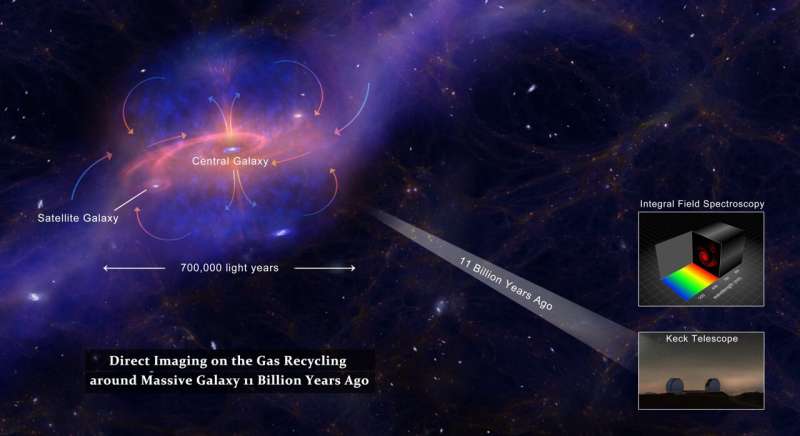May 5, 2023 report
This article has been reviewed according to Science X's editorial process and policies. Editors have highlighted the following attributes while ensuring the content's credibility:
fact-checked
peer-reviewed publication
trusted source
proofread
Gas observed moving into a massive galaxy offers evidence of material recycling

An international team of space scientists has found that observation of a gas cloud stream heading into a massive galaxy may offer evidence of gas material recycling. In their paper published in the journal Science, the group describes their observance and analysis of a gas cloud surrounding a dense galaxy cluster 11 billion light years away, and what they learned from their work.
Space scientists have, for many years, predicted that enriched gases surrounding galaxies could be pulled into such galaxies and wind up as material for making new stars. They have also suggested that such gases could have come to exist due to explosion of supernova that escape their galaxy. Thus, those gases, when they are pulled back into a galaxy are being recycled. In this new effort, the research team believes it may have found evidence of such recycling.
The researchers analyzed data from the Subaru and Keck II telescopes which were focused on a huge galaxy at redshift 2.3 which is surrounded by a nebula (cloud of gas and dust) called MAMMOTH-1. When the nebula was first discovered in 2017, it was considered to be mysterious. But a new examination suggests that the galaxy is pulling material from the nebula closer, via three distinct gas streams. They found that two of the streams pointed to a single quasar, which they suspect lives in the galaxy.
Further study of the streams showed that in addition to hydrogen and helium, they also have a lot of carbon in them, which prior research has shown is created inside of stars. Thus, the carbon in the gas stream must have once existed in a star, but now no longer does—hinting at expulsion due to a supernova. The fact that the gas in which the carbon exists appears to be part of stream heading into the galaxy suggests that it will soon be used to take part in forming new stars.
The team conducted kinematic modeling of the galaxy and nebula and it showed the gas streams spiraling into the galaxy, suggesting that they are likely part of a massive recycling process whereby stars blow up and leftover material from the explosions winds up as material used for construction of new stars.
More information: Shiwu Zhang et al, Inspiraling streams of enriched gas observed around a massive galaxy 11 billion years ago, Science (2023). DOI: 10.1126/science.abj9192
Journal information: Science
© 2023 Science X Network




















